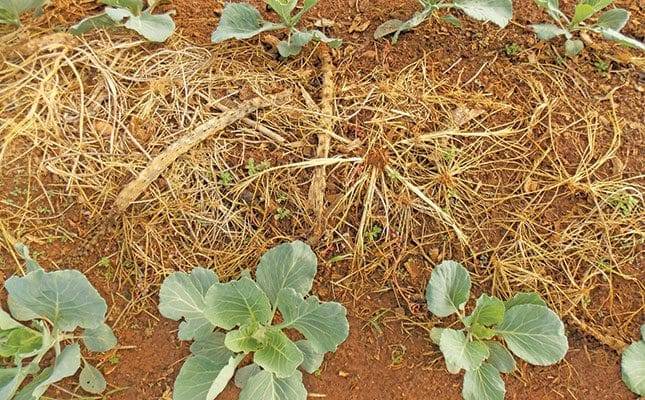Main Points In Hindi (मुख्य बातें – हिंदी में)
यहां कुछ मुख्य बिंदु हैं जो बिल केर के विचारों को संक्षेप में प्रस्तुत करते हैं:
-
जैविक सामग्री का महत्व: स्वस्थ फसलें और अधिक पैदावार सुनिश्चित करने के लिए मिट्टी में जैविक और सूक्ष्म जीवों की मात्रा बढ़ाना आवश्यक है।
-
ह्यूमस का विकास: मिट्टी में ह्यूमस की वृद्धि दर को अधिकतम करने के लिए कार्बनिक पदार्थ का महत्व और प्रभावी तरीकों की खोज को समझना आवश्यक है।
-
कवर फसल और फलियों का उपयोग: फलियां और कवर फसल मिश्रण मिट्टी की गुणवत्ता में सुधार करने के लिए महत्वपूर्ण हैं, क्योंकि ये नाइट्रोजन प्रदान करते हैं और मिट्टी की संरचना को स्थिर रखते हैं।
-
मिट्टी के जीवों का खाद्य जाल: मिट्टी में खाद्य सामग्री छोड़ने से मिट्टी के जीवों के लिए पोषण की व्यवस्था होती है, जो स्वस्थ और उपजाऊ मिट्टी बनाने में सहायक होते हैं।
- नो-टिलिंग के लाभ: बिना जुताई के मिट्टी की रक्षा होती है, जिससे पोषक तत्वों का अपघटन धीमा होता है और बैक्टीरिया की आबादी को बढ़ने का मौका मिलता है, जिससे फसलों के लिए नाइट्रोजन उपलब्धता बेहतर होती है।
Main Points In English(मुख्य बातें – अंग्रेज़ी में)
Here are the main points from the text you provided:


-
Importance of Organic Matter in Soil: Bill Kerr emphasizes that increasing the organic matter and microbial life in soil is crucial for ensuring healthy crops and higher yields.
-
Understanding Soil Composition: The first step in enhancing soil health is understanding how to increase organic matter content, which opens the door to increased productivity and profitability.
-
The Role of Carbon and Humus: Professor Steve Thien from Kansas State University provided insights into the relationship between crop residue and humus creation. He highlighted that a significant amount of carbon from dry matter can be converted into humus, which is essential for soil health.
-
Crop Rotation and Cover Crops: It is crucial to include legumes in crop rotation and cover crop mixtures to improve soil quality, as they contribute more nitrogen compared to other crops, thus aiding in humus formation.
- Benefits of No-Till Farming: Bill Kerr advocates for no-till practices, which help maintain soil structure and reduce the rapid increase of bacteria that can deplete nitrogen levels, allowing for the immediate plantings of subsequent crops without a negative impact on soil health.
Complete News In Hindi(पूरी खबर – हिंदी में)
बिल केर के अनुसार, स्वस्थ फसलों और अधिक पैदावार सुनिश्चित करने के लिए मिट्टी में जैविक और सूक्ष्म जीवों की मात्रा को बढ़ाना एक महत्वपूर्ण कदम है। वह यह मानते हैं कि बिना जुताई की तकनीक का उपयोग करके, मिट्टी की रक्षा करना और सड़ने पर मिट्टी के जीवों को पोषण देने के लिए कार्बनिक पदार्थ को जमीन की सतह पर छोड़ देना आवश्यक है।
इस विषय पर आगे बढ़ने के लिए, यह महत्वपूर्ण है कि हम अपनी मिट्टी में जैविक पदार्थों की मात्रा बढ़ाने के तरीकों को समझें। केर ने एक नया हल निकालने का प्रयास किया, जो कि मिट्टी में ह्यूमस की वृद्धि दर को अधिकतम करने पर केंद्रित था। इसके लिए, उन्होंने कृषि विज्ञान के तीन प्रोफेसरों से मदद मांगी, जिनमें से एक, कैनसस स्टेट यूनिवर्सिटी के प्रोफेसर स्टीव थिएन, ने उन्हें एक सूत्र प्रदान किया। थिएन के अनुसार, किसी भी फसल में प्रति टन लगभग 400 किलोग्राम कार्बन होता है, जिसमें से 140 किग्रा ह्यूमस बना सकता है।
यह ध्यान आकर्षित करने योग्य है कि ह्यूमस की संरचना में 50% कार्बन मौजूद होता है, और इसका कार्बन-नाइट्रोजन का अनुपात लगभग 10:1 होता है। इसलिए, जैविक सामग्री की अधिकता सुनिश्चित करने के लिए, यह जरूरी है कि हम फसल के अवशेषों और उनकी नाइट्रोजन की सामग्री को भी ध्यान में रखें।
बिल केर यह बताते हैं कि गेहूं के अवशेषों का C:N अनुपात 80:1 है, जिससे यह केवल 100 किलोग्राम ह्यूमस बना सकता है, जबकि सोयाबीन जैसे फसलों में ज्यादा नाइट्रोजन होने के कारण वे पूरी 280 किलोग्राम ह्यूमस बना सकते हैं। इसलिए, मिट्टी में सुधार के लिए, फसल चक्र में फलियों को शामिल करना बेहद जरूरी है।


मिट्टी की सुरक्षा करने और उसमें जैविक सामग्री रखने के लिए फसल के अवशेष, खाद और अन्य कार्बनिक पदार्थों को मिट्टी की सतह पर छोड़ना आवश्यक है। इस तरीके से, सूक्ष्मजीव धीरे-धीरे इस जैविक सामग्री को पचाकर मिट्टी में नाइट्रोजन संचित कर सकते हैं। यदि जैविक सामग्री को मिट्टी में डाल दिया जाता है, तो यह बैक्टीरिया की वृद्धि में तेजी लाएगा, जो बाद में नाइट्रोजन को मिट्टी में वापस छोड़ देंगे, जिसके परिणामस्वरूप पौधों की वृद्धि होगी।
मिट्टी में नाइट्रोजन की कमी की स्थिति को “नकारात्मक अवधि” कहा जाता है, जो तब होती है जब बैक्टीरिया की संख्या बढ़ जाती है और इसका अवशोषण हो जाता है। बिल केर का कहना है कि बिना जुताई के यह समस्या नहीं होती, क्योंकि अपघटन की प्रक्रिया धीमी रहती है और बैक्टीरिया की आबादी में वृदि्ध नहीं होती।
फसल की कटाई के बाद, अगर हम जुताई नहीं करते हैं, तो हम तुरंत अगली फसल लगा सकते हैं, जो कि किसानों के लिए एक बड़ा लाभ है। इस प्रकार, बिल केर के विचारों के अनुसार, जैविक और सूक्ष्म जीवों की मात्रा बढ़ाना किसानों के लिए एक अनिवार्य कदम है, जो स्वस्थ फसल उत्पादन और उच्च पैदावार प्राप्त करने में मदद करेगा।
बिल केर एक सब्जी विशेषज्ञ और प्रजनक हैं, और उन्होंने प्राकृतिक कृषि पद्धतियों को अपनाने वाले किसानों के लिए इन विचारों को साझा किया है। उनका मानना है कि केवल जैविक पदार्थों की मात्रा में वृद्धि करके ही हम अधिक लाभ और स्वस्थ फसलों की ओर बढ़ सकते हैं।
Complete News In English(पूरी खबर – अंग्रेज़ी में)
Bill Kerr emphasizes that increasing the organic and microbial content in soil is the first step towards ensuring healthy crops and higher yields. To start this journey, it is crucial to understand how to enhance organic matter in the soil. A key strategy is to avoid tillage and allow organic materials to remain on the soil surface, thus nourishing soil organisms as they decompose.
Kerr’s exploration of a new approach led him to seek a formula that would maximize the rate of humus formation in the soil. He sought assistance from agricultural science professors at three universities in the U.S., ultimately receiving a key insight from Professor Steve Thien at Kansas State University. Thien highlighted that virtually any crop yields approximately 400 kg of carbon per ton of dry matter. Of this, 140 kg can be converted into humus, while the remainder is lost as CO2 due to microbial activity.
Given that humus consists of 50% carbon, from one ton of dry matter, the maximum possible humus produced is 280 kg. The carbon-to-nitrogen (C:N) ratio in humus is around 10:1, indicating it also contains sufficient nitrogen. For instance, wheat straw has a much higher C:N ratio of 80:1, meaning one ton of wheat straw only provides about 5 kg of nitrogen, consequently yielding only 100 kg of humus. In contrast, soybean, with a richer nitrogen content, can produce up to the maximum of 280 kg of humus.
Kerr notes that this crucial understanding is often absent among farmers. This is why incorporating legumes into crop rotations is vital for improving soil health. The system requires maintaining material on the soil to ensure that soil organisms—part of the soil food web—have enough decomposable material available to sustain their activity. This material, whether crop residues, compost, or manure, should be left on the soil surface to be slowly decomposed by the soil’s microbial community.
If organic matter is incorporated into the soil, it prompts rapid bacterial growth, which seizes nitrogen from the soil, making it unavailable to plants until the bacteria decompose the organic substances and die off. This gap in nitrogen availability is termed the “negative period.” In contrast, no-till practices help avoid this negative period as decomposition occurs more gradually, preventing a significant spike in bacteria population.
By harvesting crops without tilling the soil, farmers can immediately plant the next crop, presenting a significant advantage. Kerr, who specializes in vegetable production and breeding, advocates for these methods to ensure better soil health and crop productivity.
In summary, Kerr’s approach to agriculture focuses on the vital role of organic matter and soil microbes in cultivating resilient and productive farming systems. Sustainable practices such as no-till farming and the incorporation of legumes into crop rotations not only enhance soil structure and fertility but also promote a thriving ecosystem critical for long-term agricultural success.
Source link




